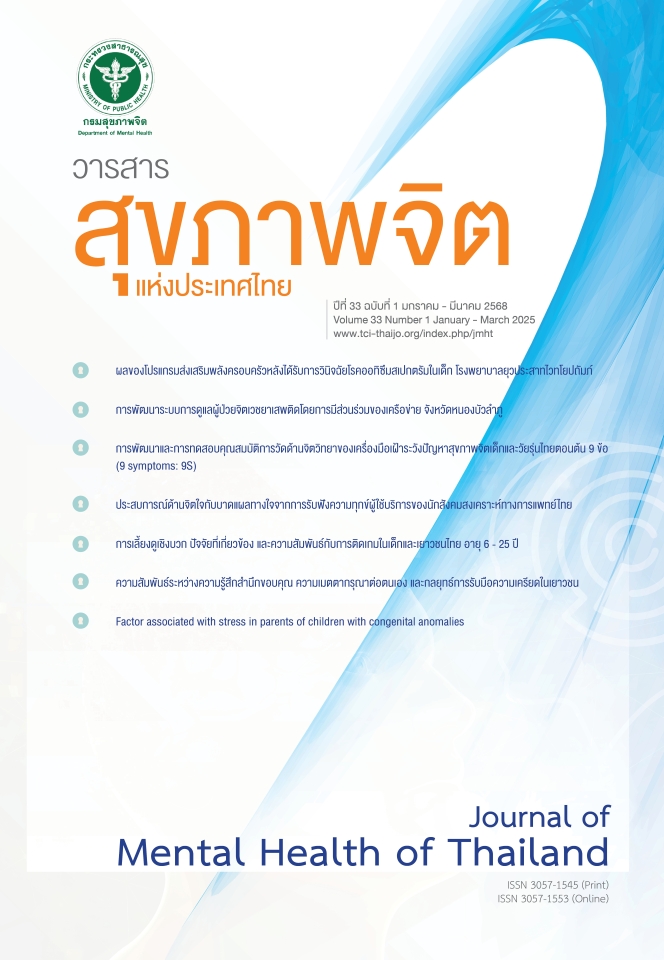ประสบการณ์ด้านจิตใจกับบาดแผลทางใจจากการรับฟังความทุกข์ผู้ใช้บริการของนักสังคมสงเคราะห์ทางการแพทย์ไทย
DOI:
https://doi.org/10.64838/jmht.2025.274036คำสำคัญ:
การพัฒนาทางจิตใจ, นักสังคมสงเคราะห์ทางการแพทย์, บาดแผลทางใจบทคัดย่อ
วัตถุประสงค์ : เพื่อทำความเข้าใจประสบการณ์และการพัฒนาทางจิตใจของนักสังคมสงเคราะห์ทางการแพทย์ไทยจากการรับรู้ความทุกข์ของผู้ใช้บริการ
วิธีการ : การศึกษาเชิงคุณภาพแนวปรากฏการณ์วิทยาแบบตีความ โดยการสัมภาษณ์เชิงลึกแบบกึ่งโครงสร้างนักสังคมสงเคราะห์ทางการแพทย์ 6 คน คัดเลือกแบบอ้างอิงด้วยบุคคลและผู้เชี่ยวชาญ เก็บรวบรวมข้อมูลตั้งแต่เดือนกันยายน พ.ศ. 2566 ถึง มิถุนายน พ.ศ. 2567
ผล : พบประเด็นสำคัญ 3 ประเด็น ดังนี้ 1) ผลทางลบจากการรับรู้ความทุกข์ของผู้ใช้บริการต่ออารมณ์ ความรู้สึก ความคิด และการดำเนินชีวิตประจำวัน 2) การพัฒนาทางจิตใจจากการรับรู้ความทุกข์ของผู้ใช้บริการในด้านการรับรู้ถึงคุณค่าภายใน คุณค่าของผู้คน คุณค่าของชีวิต และคุณค่าของงาน และ 3) การจัดการผลทางลบโดยการแสวงหาแหล่งสนับสนุนและค้นหาแนวทางจัดการความเครียด
สรุป : นักสังคมสงเคราะห์ทางการแพทย์ไทยประสบทั้งบาดแผลทางใจและการพัฒนาทางจิตใจจากการรับฟังความทุกข์ของผู้ใช้บริการ ควรมีการสนับสนุนทางสังคมและการดูแลสุขภาวะทางจิตของนักสังคมสงเคราะห์ เพื่อลดผลกระทบทางลบจากการทำงาน ร่วมกับการส่งเสริมความเข้มแข็งและการพัฒนาทางจิตใจ
Downloads
เอกสารอ้างอิง
Khetjoi S, Moonma A, Raisanguan S, Thasa W. Social workers’ roles in social welfare services in hospital. Pañña Panithan Journal. 2021;6(2):29-42. (in Thai)
Vîrgă D, Baciu EL, Lazăr TA, Lupșa D. Psychological capital protects social workers from burnout and secondary traumatic stress. Sustainability. 2020;12(6):2246. DOI: https://doi.org/10.3390/su12062246
Chitsawang S, Phetmunee T, Chitsawang N, Kanthawong W. Violence in Thailand. Journal of Social Work. 2023;31(1):47-88. (in Thai)
Tasee P. The study and enhancement of social work student’s self-compassion through group counseling [dissertation]. Bangkok: Srinakharinwirot University; 2017. (in Thai)
Prasertsom P, Yotanyamaneewong S. Conditions and impacts of burnout in child protective service workers. Journal of Social Work. 2021;29(2):66-93. (in Thai)
Holmes MR, Rentrope CR, Korsch-Williams A, King JA. Impact of COVID-19 pandemic on posttraumatic stress, grief, burnout, and secondary trauma of social workers in the United States. Clinical Social Work Journal. 2021;49(4):495-504. DOI: https://doi.org/10.1007/s10615-021-00795-y
Pearlman LA, McCann IL. Vicarious traumatization: a framework for understanding the psychological effects of working with victims. Journal of Traumatic Stres. 1990;3(1):131-49. DOI: https://doi.org/10.1007/BF00975140
Bride BE. Prevalence of secondary traumatic stress among social workers. Soc Work. 2007;52(1):63-70. DOI: https://doi.org/10.1093/sw/52.1.63
Figley CR. Compassion fatigue: coping with secondary traumatic stress in those who treat the traumatized. New York: Brummer/Mazel; 1995.
Arin N. The study of antecedents and consequences of psychological capital affecting psychological outcomes and work performance under adverse situation of public health officers in southern border provinces [dissertation]. Bangkok: Srinakharinwirot University; 2012. (in Thai)
Kreitzer L, Brintnell SE, Austin W. Institutional barriers to healthy workplace environments: from the voices of social workers experiencing compassion fatigue. British Journal of Social Work. 2020;50(7):1942-60. DOI: https://doi.org/10.1093/bjsw/bcz147
Pollard LW. Social worker experience of fatal child abuse. British Journal of Social Work. 2018;48(7):1948-66. DOI: https://doi.org/10.1093/bjsw/bcx138
Fixsen A, Ridge D, Evans C. “Momma bear wants to protect”: vicarious parenting in practitioners working with disturbed and traumatised children. Counselling & Psychotherapy Research. 2020;20(4):680–8. DOI: https://doi.org/10.1002/capr.12285
Band-Winterstein T, Goldblatt H, Alon S. Social workers’ encounters with elder abuse and neglect: giving meaning to their experiences. British Journal of Social Work. 2021;51(2):564-82. DOI: https://doi.org/10.1093/bjsw/bcaa165
Cañas-Lerma AJ, Hidalgo-Andrade P, Araujo-Lugo V, Moya G, Verger S. Emotional experiences in palliative care and professional quality of life: a qualitative approach. Palliat Care Soc Pract. 2024;18:26323524241246531. DOI: https://doi.org/10.1177/26323524241246531
Waegemakers Schiff J, Lane AM. PTSD symptoms, vicarious traumatization, and burnout in front line workers in the homeless sector. Community Ment Health J. 2019;55(3):454-62. DOI: https://doi.org/10.1007/s10597-018-00364-7
Finklestein M, Stein E, Greene T, Bronstein I, Solomon Z. Posttraumatic stress disorder and vicarious trauma in mental health professionals. Health & Social Work. 2015;40(2):e25-31. DOI: https://doi.org/10.1093/hsw/hlv026
Arnold D, Calhoun LG, Tedeschi RG, Cann A. Vicarious posttraumatic growth in psychotherapy. J Humanist Psychol. 2005;45(2):239-63. DOI: https://doi.org/10.1177/0022167805274729
Manning-Jones S, de Terte I, Stephens C. Vicarious posttraumatic growth: a systematic literature review. International Journal of Wellbeing. 2015;5(2):125-39. DOI: https://doi.org/10.5502/ijw.v5i2.8
Richard G. Tedeschi, Shakespeare-Finch J, Taku K. Posttraumatic growth: theory, research, and applications. New York, NY: Routledge; 2018. DOI: https://doi.org/10.4324/9781315527451
Chankomut P. Inequality of Thailand: situation and policy solutions. Journal of Roi Kaensarn Academi. 2024;9(6):1028-41. (in Thai)
Smith JA, Flowers P, Larkin M. Interpretative phenomenological analysis: theory, method and research. Los Angeles: SAGE; 2009.
Peled-Avram M. The role of relational-oriented supervision and personal and work-related factors in the development of vicarious traumatization. Clinical Social Work Journal. 2017;45(1):22-32. DOI: https://doi.org/10.1007/s10615-015-0573-y
Duangurai A. Psychological experiences of posttraumatic growth in veterans [master’s thesis]. Bangkok: Chulalongkorn University; 2015. (in Thai)
Prohmpetch W, Taephant N, Pisitsungkagarn K. Factors predicting posttraumatic growth in university students in southernmost Thailand. Journal of Mental Health of Thailand. 2022;30(4):331-44. (in Thai)
Tsirimokou A, Kloess JA, Dhinse SK. Vicarious post-traumatic growth in professionals exposed to traumatogenic material: a systematic literature review. Trauma Violence Abuse. 2023;24(3):1848-66. DOI: https://doi.org/10.1177/15248380221082079
Deaton JD, Ohrt JH, Linich K, McCartney E, Glascoe G. Vicarious posttraumatic growth: a systematic review and thematic synthesis across helping professions. Traumatology. 2022;29(1):17-26. DOI: https://doi.org/10.1037/trm0000375
Ben-Porat A, Itzhaky H. Implications of treating family violence for the therapist: secondary traumatization, vicarious traumatization, and growth. Journal of Family Violence. 2009;24(7):507-16. DOI: https://doi.org/10.1007/s10896-009-9249-0
Bell H. Strengths and secondary trauma in family violence work. Soc Work. 2003;48(4):513-22. DOI: https://doi.org/10.1093/sw/48.4.513
Rogers CR. On becoming a person: a therapist’s view of psychotherapy. Boston: Houghton Mifflin; 1961.
ดาวน์โหลด
เผยแพร่แล้ว
รูปแบบการอ้างอิง
ฉบับ
ประเภทบทความ
สัญญาอนุญาต
ลิขสิทธิ์ (c) 2025 วารสารสุขภาพจิตแห่งประเทศไทย

อนุญาตภายใต้เงื่อนไข Creative Commons Attribution-NonCommercial-NoDerivatives 4.0 International License.
- ผู้อ่านสามารถนำข้อความ ข้อมูล จากวารสารไปใช้ไปใช้ประโยชน์ทางวิชาการได้ เช่น เพื่อการสอน เพื่อการอ้างอิง แต่การนำไปใช้เพื่อวัตถุประสงค์อื่น เช่น เพื่อการค้า จะต้องได้รับอนุญาตเป็นลายลักษณ์อักษรจากกรมสุขภาพจิตก่อน
- ความคิดเห็น ข้อมูล และบทสรุปต่าง ๆ ที่ลงตีพิมพ์ในวารสารสุขภาพจิตแห่งประเทศไทยเป็นของผู้เขียนบทความและมิได้แสดงว่ากองบรรณาธิการหรือกรมสุขภาพจิตเห็นพ้องด้วย




